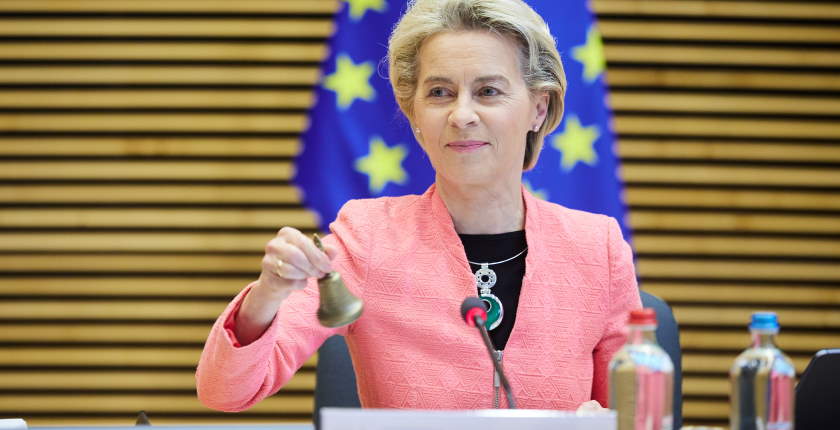
Ursula von der Leyen (photo: European Commission)
The European Commission adopted a package of 12 draft laws for the climate, energy, land use, transportation, and taxation sectors designed to help achieve net greenhouse gas emissions reductions by at least 55% by 2030, compared to 1990 levels, and make Europe climate-neutral by 2050. The package also makes the European Green Deal a reality.
The Fit for 55 package intends to ban new diesel and petrol cars sale from 2035, tax jet fuel, introduce carbon border tax on the import of iron and steel, cement, fertilizer, aluminium, and electricity produced outside the EU, establish a carbon trading system for the road transportation and building sectors, tighten the existing EU Emissions Trading System (EU ETS) and expand it to shipping, and increase the renewables share target from 32% to 40%.
The proposals must now be negotiated with 27 member states and the European Parliament
Here is some data demonstrating the scale of the change the Fit for 55 package intends to achieve: by 2019, the EU had cut its emissions by 24% from 1990 levels, and now it needs a reduction of 55% by 2030, and 100% by 2050.
Fit for 55 now faces negotiations with 27 member states and the European Parliament in order to become law.
The Fit for 55 package represents legislative tools to deliver on the targets agreed in the European Climate Law and fundamentally transform our economy and society for a fair, green and prosperous future, according to the European Commission.
Ursula von der Leyen: the fossil fuel economy has reached its limits
The EU executive has invited the European Parliament and the Council to swiftly begin their legislative work on the proposals, and to ensure that they are treated as a coherent package, respecting the multiple interconnections between them.
“The fossil fuel economy has reached its limits. We want to leave the next generation a healthy planet as well as good jobs and growth that does not hurt our nature. The European Green Deal is our growth strategy that is moving towards a decarbonised economy. Europe was the first continent to declare to be climate neutral in 2050, and now we are the very first ones to put a concrete roadmap on the table. Europe walks the talk on climate policies through innovation, investment and social compensation,” said Ursula von der Leyen, President of the European Commission.
Carbon pricing – aviation, shipping, road transport, heating
The Commission has proposed a revision of the EU ETS. It wants to lower the overall emission cap even further and increase its annual rate of reduction. The Commission has suggested phasing out free emission allowances for aviation and aligning it with the global Carbon Offsetting and Reduction Scheme for International Aviation (CORSIA), as well as including shipping emissions for the first time in the EU ETS.
To address the lack of emissions reductions in road transportation and buildings, a separate new emissions trading system is set up for fuel distribution for road transportation and buildings, the Commission said.
The ReFuelEU Aviation Initiative will make it mandatory for fuel suppliers to blend increasing levels of sustainable aviation fuels in jet fuel taken on-board at EU airports, including synthetic low carbon fuels, known as e-fuels. Similarly, the FuelEU Maritime Initiative will stimulate the uptake of sustainable maritime fuels and zero-emission technologies by setting a maximum limit on the greenhouse gas content of energy used by ships calling at European ports.
All new cars registered as of 2035 to be zero-emission
According to the Commission, tighter CO2 emissions standards for cars and vans will accelerate the transition to zero-emission mobility by requiring average emissions of new cars to come down by 55% from 2030 and 100% from 2035 compared to 2021 levels.
As a result, all new cars registered as of 2035 will be zero-emission, the Commission said.
The revised Alternative Fuels Infrastructure Regulation will require EU member states to expand charging capacity in line with zero-emission car sales, and to install charging and fueling points at regular intervals on major highways: every 60 kilometres for electric charging and every 150 kilometres for hydrogen refueling.
Carbon border tax to be introduced from 2023 to 2026
The Carbon Border Adjustment Mechanism will be introduced gradually from 2023 to 2026. Initially it will be applied to iron and steel, cement, fertilizer, aluminium and electricity.
A new mechanism will put a carbon price on imports of a targeted selection of products to ensure that ambitious climate action in Europe does not lead to ‘carbon leakage’, the Commission said.
This will ensure that European emission reductions contribute to a global emissions decline, instead of pushing carbon-intensive production outside Europe. It also aims to encourage industry outside the EU and our international partners to take steps in the same direction.
Renewable energy target to be increased to 40%
In order to lower the emission from energy production and use, which accounts for 75% of EU emissions, the Commission has proposed a renewable energy share to be increased to 40%, under the revised Renewable Energy Directive.
All EU member states will contribute to this goal, and specific targets are proposed for renewable energy use in transportation, heating and cooling, buildings, and industry, according to the Commission.


















Be the first one to comment on this article.